Enchanted’s popularity is undoubtedly down to two men: director Kevin Lima and executive producer Chris Chase. While Lima honed his creative vision for the film and drew out perfect performances from his cast, Chase worked behind the scenes to put all the ingredients in place in order to pull the film together. Jeremie Noyer concludes Animated Views’ series on the making of Disney’s new classic by speaking to both men about their successful partnership and how the magic of Andalasia was brought to the screen!
Please click on the many exclusive developmental images from Enchanted throughout both interviews to view larger pop-up versions (your browser will remain on this page). All artwork reproduced by kind permission.
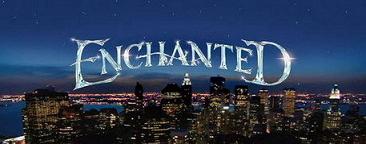
Kevin Lima: From Animation To Live-Action…And Back Again!
Every good story has a good ending – a happy one, of course! And our following the creation of Enchanted is no exception to the rule, since we have the privilege of talking with the film’s director, Kevin Lima. As he says, he certainly was the right person to helm the movie! One, because of his impressive background being associated with so many talents in the world of visual arts, from puppetry to animation, and from comics to live-action. And two, because of this true love for his art and his true love for what Disney stands for.
In fact, Kevin’s vocation goes back to his fifth year, when he discovered a book on animation by the late, legendary Preston Blair, who was also an animator on Pinocchio, Fantasia and Bambi. During his studies, Kevin drew comics for his school newspapers, but his interest in animation really blossomed when he discovered the art of puppetry in a workshop in Rhodes Island. After practicing this art for eight years, he went to Boston Emerson College and then Cal Arts, of course, before being hired by Disney on a Sport Goofy special. Then he became involved in different projects, from The Brave Little Toaster to The Lion King, also becoming a director for the first time at the age of 33 on A Goofy Movie! The rest is history, ranging from co-directing on Tarzan for Walt Disney Feature Animation to directing the live-action 102 Dalmatians for Walt Disney Pictures and the two Eloise TV movies for ABC.
Now, for an artist with so many strings to his bow, Enchanted certainly was the perfect fit, being a unique combination of so many different technical and artistic skills and needing someone with a sincere love and empathy for the characters, the heritage and the subject matter. So, get enchanted by Kevin Lima!
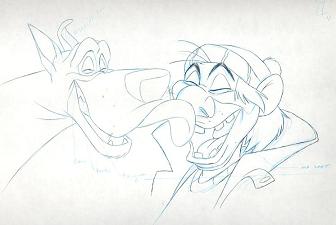 Animated Views: You’re well-known for being one of the key-artists in Disney’s revival during the 90s. How do you see that period now?
Animated Views: You’re well-known for being one of the key-artists in Disney’s revival during the 90s. How do you see that period now?
Kevin Lima: I’ve never quite thought of myself in those terms. I think what we, as a group were trying to do, really, was making movies that we loved, and I think, for most of us, that goes back to redefining what we looked at when we were children. And it’s especially true for me. I know that I mostly make movies about things that affected me as a child and things that I fantasized about when I was a child. I’m trying to put that into what I do as an adult and I think that’s really what we all tried to do: look back to our past, remember what we loved when we were children and try to put that on screen.
AV: What do you remember from that time at Disney?
KL: I’ve done many different things during my years at Disney. I never stayed in one place for very long. I was an animator on Oliver & Company, I did Fagin, and then I did character design of The Little Mermaid and Aladdin. I did some visual development work on The Lion King, and then I actually left the studio at that point.
AV: How did you come to direct A Goofy Movie?
 KL: Well, I actually had gone to the executives at Disney and asked them to direct. That was something that I really wanted to do, because I had directed some theater and I was a puppeteer when I was a child through college. And I really felt like that’s what I wanted to be. I had tried many different hats at Disney and I decided that it was difficult for me to stay and just do one thing. I wanted in fact to contribute, to have my hands in many different parts, so to speak, in many different pieces of animation. So, I decided it might be good for me to become a director.
KL: Well, I actually had gone to the executives at Disney and asked them to direct. That was something that I really wanted to do, because I had directed some theater and I was a puppeteer when I was a child through college. And I really felt like that’s what I wanted to be. I had tried many different hats at Disney and I decided that it was difficult for me to stay and just do one thing. I wanted in fact to contribute, to have my hands in many different parts, so to speak, in many different pieces of animation. So, I decided it might be good for me to become a director.
I went to the executives and asked them if there would be any chance that I could direct something, and they said that there was very little chance of that. They were releasing one movie a year or a year and a half and they had their directors lined up for many years to come. So, I left the Studio and I actually went to work at a different studio called Hyperion. I worked in developing a couple of films for them which never got made. We were developing a version of Thumbelina at one point. Then I got a call from Walt Disney Television Animation to come and look at A Goofy Movie. I went over and saw it as an opportunity to not only tell a story that I thought I could tell well, you know, but also get a break in directing animation. So, that how I got to that project.
AV: How did you want to tell that story?
KL: Well, I originally looked at Goofy Movie as a family comedy. I said: “why can’t we make a John Hughes movie in animation? Why can’t we go right for some of the themes that trouble kids as they grow up?”, and I think that John Hughes did that in a lot of his films. So, it was the perfect opportunity to work on this relationship. I really looked to do something that was a little bit more contemporary, in a sense, than the traditional Disney films at that moment, and tried to find different voices for the characters. The voice for Max, who is the young adolescent coming of age, and at the opposite for Goofy, which is definitely rooted in a completely different place than what adolescent children are going through today. So, we tried to set up that dichotomy, those opposites, in the piece.
AV: You were a puppeteer for eight years in college. Did that experience have a particular influence on your approach to animation and to film direction?
KL: I think it definitely did. I became a puppeteer when I was 12 years old. I was an apprentice puppeteer with a professional group called The Puppet Workshop in Rhodes Island. I think it really gave me the opportunity to explore all the aspects of putting together a story, really, because we were all working on stories, we improvised our own stories as a group. We made all the puppets, defining characters. We did all the things that go into the making of a good piece of storytelling. So it was really a good start for me because I was practicing all of those forms very early on. It also was helpful in that it was within the genre that ultimately I wanted to be a part of, which is children’s entertainment. I was performing to children at a very, very young age. I was a part of, you know, re-acting and acting for children, in a way. So, I think I have a different sort of a sensibility about what that is, because I was a part of this give-and-take very, very young.
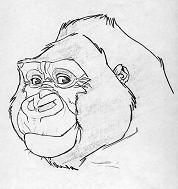 AV: How was it to be directing an animated movie alone, whereas most of the films of that period were directed by two people – just like Tarzan, which you co-directed with Chris Buck?
AV: How was it to be directing an animated movie alone, whereas most of the films of that period were directed by two people – just like Tarzan, which you co-directed with Chris Buck?
KL: You know, there are two totally different ways of making movies. When you’re alone, when you’re a single director, certainly everything falls upon your own shoulders, you don’t get to share that weight. And it really depends upon how big the film is, I think, ultimately, because A Goofy Movie, although it took the same amount of time to make as Tarzan, was a small, more manageable film. We had less artists working on the film, we were more contained, we didn’t use different studios around the world. A Goofy Movie was made totally in France, and I actually went there and worked with that crew in Paris.
On something like Tarzan, I think, at any given time, there were four hundred artists working on your film, which makes it more difficult. If you want to maintain a reasonable lifestyle outside of work, I think you have to, in a way, co-direct, on a very large film of that size. I was really lucky on Tarzan to have a co-director, Chris Buck, who was completely in synch with me. We were completely in the same plan. I can see how it would be incredibly difficult to do a movie if the co-directors don’t see the same movie. It was very important to me when going into a collaboration with another director that we see exactly the same movie. That one director is trying to make one movie, while the other director is trying to make his own, I think that’s the recipe for disaster!
AV: What kind of films do you like?
KL: Oh, boy ! I would have to say that my favorite films have in some way to do with families, with family dynamics. There are two particular films that I love which are To Kill A Mockingbird and more recently Searching For Bobby Fisher. I have a soft spot for Terry Gilliam. I love his films, I think, because they speak to the child inside the adult in many ways. He’s not afraid to embrace the child, in a sense, which I find very, very interesting.
AV: You’re always very careful with all the ingredients of your films, including music. What kind of music do you like?
KL: I have very, very eclectic taste. I tend to like everything from Broadway musicals – I went to a lot of Broadway musicals, I’m especially a fan of Stephen Sondheim – all the way to a lot of modern music. So, it varies greatly. In fact, sometimes, my wife tells me: “what are you listening to, now?”, because there’s never sort of one particular piece of music that I stick with!
AV: How did you come into directing Tarzan?
KL: Well, actually, when I was finishing A Goofy Movie in Paris, I got a phone call from Jeffrey Katzenberg saying that he’d like me to do Tarzan and he wanted me to do it through the TV division. He wanted to set up a new studio in Canada to do the project and I basically told him that he was crazy. Starting a new studio, with brand-new talents who haven’t worked on a Disney film before and having them animate a half-naked man would be near impossible. I told him that he would not be happy with the result. He called me every two days for a couple of weeks and then I read in Variety that he was leaving the studio. I was very, very surprised that that was happening and I thought: “Ok, there goes my opportunity. I certainly won’t get to direct another film at Disney”, because in a way, Jeffrey was the one who believed in me, who supported my journey. And I thought that, because earlier in my experience with Feature Animation, they had said that they had all the directors they needed, I would be off looking somewhere else for job. And I got a call from Michael Eisner who said: “we’re going to do Tarzan over Feature Animation and we’d like you to do it!” That made all the difference. I suddenly thought: “Ok. We can make that movie, now. The talent basis is there.” That’s how Tarzan came about!
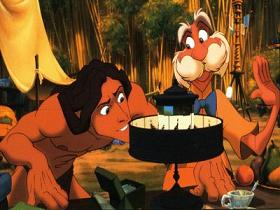 AV: After a decade of animated musicals, you created a new approach to songs in an animated feature. Can you tell me about that?
AV: After a decade of animated musicals, you created a new approach to songs in an animated feature. Can you tell me about that?
KL: Well, first we had chosen Phil Collins to be our musical voice for the film. We did that for many reasons. One reason is because of the emotional sort of quality of his connection with his songs. When Phil Collins sings the songs, you feel emotionally connected to his storytelling. The other reason is because he’s a phenomenal percussionist and we wanted to define the movie musically through percussion. We thought that would be an interesting way to do it, and it sets it apart from The Lion King in many ways because Lion King connects itself to its music through its choral work. It’s mostly about voice and we wanted to find a different way to define our jungle, so to speak.
AV: With the cinematographic language in animated films, Tarzan also really moved forward, borrowing even from music video.
KL: I think definitely that modern film language (and that includes MTV or music video) in a way influenced the film in a major way. First of all, we had a pop singer, with songs that felt like pop songs ultimately. They didn’t feel like Broadway show tunes. So, this is a different rhythm that we sort of used to create the filmic language of each of the pieces. Tarzan is a film that is full of energy and movement and we tried to make that a part of our filmic language, especially in the songs. The songs also do a specific thing within the movie: they tend to keep pushing forward in time. You go into one song and the character is five years old; you come out the other end and he’s a grown man. You go into another song like Strangers Like Me and he knows nothing about men, and he comes out the other end with some understanding of what it is to be a man. So, certainly there’s a huge time change within the songs, which allowed us to fracture the storytelling in a bigger way. It wasn’t happening in the moment, right in front of you. We were moving through time. I think that definitely influenced the way in which the songs were storyboarded and cut. So, yes, in many ways, the contemporary language of editing and montage certainly brought about the pacing, the tone and the way in which those sequences were put together.
AV: With 102 Dalmatians, you went into live-action. Was this move your choice?
KL: It was not my personal choice to do 102 Dalmatians. I had actually wanted to do a live-action film after Tarzan. So, I was finishing Tarzan, I was looking for a film to do and reading scripts. Peter Schneider, who had left Disney animation and become head of feature film production at Disney called me and said: “I’d like you to do this film!”. I had read the script and I said: “you know, I don’t think I can do this. I don’t think I can do a sequel to a remake of a classic Disney film. I don’t think I have that in me.” And, strangely enough, almost everyone I knew said: “you’re making a huge mistake. This is a huge opportunity.”
 I was still sort of at the point where I was saying: “no, I don’t think I want to do it”, and Glenn Close called me. She was the voice of Kala in Tarzan and she said: “Kevin, I want you to do this movie!” That was the thing that really convinced me to do it, that I would get the opportunity to work with a world-class actress, someone who had some respect for me and who wouldn’t be looking at me in the way that some actress might look at a first-time director. I felt sort of confident in that, that she would be there for me. And in many ways, she became sort of my mentor during the making of this movie. I would go to her when I had troubles. When something would happen on the set that I didn’t handle, I would actually talk to Glenn, and Glenn in many ways helped me through that first film. So, it wasn’t my choice in a way. The movie sort of chose me.
I was still sort of at the point where I was saying: “no, I don’t think I want to do it”, and Glenn Close called me. She was the voice of Kala in Tarzan and she said: “Kevin, I want you to do this movie!” That was the thing that really convinced me to do it, that I would get the opportunity to work with a world-class actress, someone who had some respect for me and who wouldn’t be looking at me in the way that some actress might look at a first-time director. I felt sort of confident in that, that she would be there for me. And in many ways, she became sort of my mentor during the making of this movie. I would go to her when I had troubles. When something would happen on the set that I didn’t handle, I would actually talk to Glenn, and Glenn in many ways helped me through that first film. So, it wasn’t my choice in a way. The movie sort of chose me.
AV: Cruella chose you !
KL: Yes, Cruella De Vil chose Kevin Lima to direct her movie! That’s sort of strange!
AV: Did you change your mind about this movie, then?
KL: I don’t think, if I could do it all again, that I would necessarily choose it as my first film! It was a very, very difficult experience for me because the script doesn’t speak to me personally. If you look at the other two films that I’ve done, A Goofy Movie and Tarzan, you can very much see a theme. You can see themes arise that are in both of those films and that have to do with the relationship between fathers and sons, about creating new family, about the modern dynamics of what it is to be a family. It’s all very much part of my life. I come from a family of divorce and I haven’t seen my father in 25 years. I just saw him again a few years ago. So, they’re all very much themes that are inside of me.
I got 102 Dalmatians and those themes didn’t exist. So, to begin with, I wanted to re-write some of the script to put some of those things so that I could have some emotional connection to the material. But that never happened. The Studio had reasons that they didn’t want to change the script moving in that direction. So, I took it as my opportunity to do a first film. It’s really sort of been a mixed blessing in a way because there are things that I got to love about the movie. I love the work that was done with the dogs, I really love the beginnings of that relationship of Oddball and her family, I like the way some of those pieces turned out. I’m happy that we were able to create a different beginning for the Cruella myth: the beginning of the film takes the Cruella myth and turns it on its head a little bit, which I think is interesting. But overall, the piece doesn’t speak to my heart. That’s why I’m always looking for something that really speaks to who I am as a person and go back to that thematic feel.
AV: In that movie, there was already an attempt to pay homage to classic Disney films like you did on Enchanted.
KL: When I was filming 102 Dalmatians, I thought it would be fun to juxtapose the puppies watching their favorite Disney film, Lady and the Tramp, with the humans, Kevin and Chloe, mirroring the on-screen action of falling in love. I simply thought it would be a fun in joke for all of us who hold Disney animation close to our hearts.
If anything I tried to stay away from the same references in Enchanted. The most obvious being the names of the Italian restaurants. In 102 Dalmatians the restaurant is a direct homage – Tony’s. In Enchanted, I decided to use a less direct reference and named the restaurant Bella Notte after the song sung during the famous spaghetti eating scene.
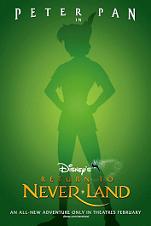 AV: Can you tell me about your input on Return to Neverland?
AV: Can you tell me about your input on Return to Neverland?
KL: I actually came over the project very, very late. I was off looking for a film to do and there was a thread of strikes, here. There was no work to be found. Then I got a call from David Stein, who was my creative executive on Tarzan, who had moved over to Television Animation, to become there the head at that moment. He said: “we need some help. We’ve put together this film, Return to Neverland, as a direct-to-video and we’ve decided to release it theatrically. I was wondering if you had some time to come over and consult”. So, that’s exactly what I did. I came over, I looked at the film and I gave them suggestions on what I would do with it. They asked me to stay on and implement those suggestions. So, I spent about 6 months working on the movie. It was totally animated when I got involved and we re-animated I’d say probably 600 feet of the film, which isn’t much when you look at the overall film being 6000 feet worth of film. I was involved in editing the film, trying to create a better sense of pacing and we added a lot of camera work to the film. We actually heightened the sense of how the camera is used throughout the piece.
AV: How are your credited on that film?
KL: I’m credited as “very special thanks to”! Because ultimately, the film is not my vision. It’s someone else’s vision. I was happy to come in, help them finish it and hopefully raise the bar 10% – 20% to make it presentable as a theatrical release.
AV: Whereas the original movie focused on Mrs. Darling through the idea of motherhood, this sequel seems to turn rather to Mr. Darling’s side?
KL: In many ways, I think you’re right. Jane is very much down that path of having lost her childhood. So, the film is rather about reclaiming your childhood, it’s about rediscovering the necessity of fantasy in your life.
AV: Hence its taking place during a period of deep despair, World War II.
KL: Yes. It actually sets up the reasons for not believing. How can you believe in a world of fantasy when you’re presented with a world of terror? So, Jane has gained a sense of responsibility to make it through big, bad times in her life. And I think ultimately what the movie says is that, even in times of hardship, it is important to hold on to your naive side. That’s really what it does. It sets up a contrast for something for her to react to.
AV: The result is very impressive and touching at the same time!
KL: I think if there were any of the Disney films that I would have liked to have been a part of the sequel, it would be definitely this film. Peter Pan was always a favorite of mine as a child. I love the sort of escapist quality and the playfulness of the original film. That’s a quality I enjoy very much, this whole idea that you get to leave your real world and go somewhere else, that there is another world out there where you can fly or animals talk. A world where playing is the most important thing! So, I think in many ways the sequel has this same magic that the original had, and I’m proud of that, I’m proud of the fact that it speaks back to the original film and holds on to it.
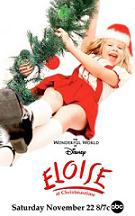 AV: Can you tell me about Eloise? How did you get to do these two adorable TV movies that are Eloise at the Plaza and Eloise at Christmastime?
AV: Can you tell me about Eloise? How did you get to do these two adorable TV movies that are Eloise at the Plaza and Eloise at Christmastime?
KL: I read about Denise Di Novi in Variety, that she was in fact going to produce a version of it for ABC and I called. I basically called Denise Di Novi and said: “I want to direct this movie!” And I think they were happy to have someone who knew the work, who was that dedicated to it and who had a feature film background. I’ve known the books my whole life because I, being an animator, to begin with – someone who draws – have always been interested in children’s books. When I was a kid, I went to a library constantly, to the children’s books section, because I loved illustration. And that’s really my introduction to most children’s work, including some of the great classics like Alice in Wonderland. And I think you can see my love for illustrations in Eloise, the movies, because I went out of my way to create those exact illustrations on screen. If you know the book, if you’re familiar with the illustrations in the book, you can literally go through the movie and find almost every illustration within the film. And that comes from my love of art, of drawing. In this work, I wanted to see whether or not the illustration could actually be translated into a filmic image. That was really important to me. Hilary Knight is my biggest fan, now, for having brought his work in 3D! He was so thrilled to be able to collaborate with someone who cares about that, who cares about the visual image in that way!
AV: How did you come to work with Julie Andrews, who is fabulous in the role of Eloise’s Nanny?
KL: Actually, when I became involved, they said that Julie Andrews was interested. And the first thing I thought was: “oh, no! This might not be the right choice!”, because I was afraid of her image. She had played the most famous nannies of all and both of those nannies are, in a way prim and proper – and one of them in particular is practically perfect in every way! I was afraid she would impose that upon the role. So, when I met her, the first thing I asked was how willing she was to become the nanny in the book, how willing she was to become the anti-Mary Poppins, so to speak. And that was in fact also her goal. She wanted to turn the whole thing down and not be what she was, but to break them all, in fact, and be the nanny that we see in the book. Actually, the nanny in the book is not perfect. She likes to drink, she smokes, she’s not terribly attentive, she watches TV while Eloise runs around the building. So, how do you take what’s wonderful about Julie and her abilities and add them to the traits of the nanny from the book?
The first thing was really about changing what Julie looks like physically. Because Julie is a beautiful woman, truly. So, what we did was that we changed her silhouette, the way her body looks. She actually wears a faux-rubber bump to make her bottom bigger, to create more of that pigeon-breasted shape on her. We also wigged her, we gave her a wig which had a lot of grey in it, which is constantly a mess, which makes her seem like no nanny that she’d ever made, because with Mary Poppins, every hair is in place, constantly. And then she talked a lot about where Nanny came from, what her heritage is, where she was born and how those things would affect who she is. What we decided is that she was probably from a cockney upbringing. So, we gave her those moments of mispronunciation, of using that strong accent. In fact, it’s in the Christmas show where she tries to cover up her accent pretty heavily. And also, how do we physically make her different? Instead of standing with her heels together and her toes pointed out as Mary Poppins does, we gave her sort of a horsey gate, you know. She walks kind of like a man. She has a very wide stride, her gestures are large. When she sits, she doesn’t put her legs together. Her legs are spread. So, a lot of those things were added to making the nanny from the book come alive. All the things I talked about are also cues that came from the illustrations. We looked at the illustrations and used those as cues to how she would walk, how she would stand, how she would run. It all became a way to physicallize a character. So, when she said yes, that’s because she was very interested in creating an anti-Mary Poppins and doing something very different. And I thought what she’s done was really great!
And you know the other thing that was wonderful about it is that Julie Andrews brought the set to life. Everyone was thrilled to be working on the set with this woman. In fact, much of the talent that was involved became involved because of Julie. They thought: “Well, Julie Andrews is in this. It must really be something special and I want to be a part of it!” And many people from the feature film world signed on this movie because they were getting a chance to work with someone as wonderful as she. She would come on the set every morning and say “hello!” to everyone. She came up every morning, gave me a kiss and said: “how are you today, my love?” and it just warmed my heart because she was the woman that I admired so greatly saying that she loved me! And would walk away and for twenty minutes, I’d be thinking: “Mary Poppins loves me!” It really helped sort of make every day of shooting a joy because of that woman!
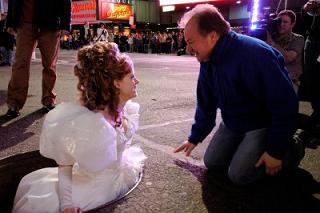
AV: You began your career as a puppeteer and then as an animator and then as a live-action filmmaker. The making of Enchanted looks like the story of your life!
KL: In so many ways, this was the perfect movie for me. I saw Jungle Book when I was five and I wanted to be an animator my entire life. And I achieved that goal along the way. I was a puppeteer, I had done some theater, so I have that live-action bug, and then I went into the business and I was an animator, very much classically trained. And then I wanted to grow a little bit after making Tarzan which I thought was probably the best animated film I could make. So, I did a couple of live-action films and now here I am bringing both those arts together. I can’t imagine a better way to spend the rest of my career than exploring how these two worlds intertwine. Not too much precisely how can 2D animated character can come to life, but how you make a new kind of movie that isn’t animated and isn’t live-action, but a combination of the two.

AV: It’s been quite a while since we first heard about the Enchanted project. Why did it take so long and how did you come aboard?
KL: I wish I knew what took them so long because it seemed very straightforward to me. They have been working on this movie for six years before I was involved. I think they were having troubles finding the proper tone of the movie: how much of a parody of Disney is it? How do you make it different from Shrek? How dark can the elements be? And I think that just took them a lot of time. They had many directors. I think four directors and five screenwriters over that period, all trying to crack the nut.
What I did as I came in, I read it in 2001 and I went to them and I said: “You know what? This is the perfect movie for me. I’ve just finished 102 Dalmatians. If there ever was a Disney movie, that was right this one! It combines animation and live-action: I understand Disney animation, I love classic Disney animation. I should be the guy!” And I think they were concerned at that time that maybe I would be too sentimental. Because I liked it too much! They were saying that maybe the movie had to be darker. And five years later, I asked: “What’s going on with Enchanted? I still think it would be great for me!” At that moment, they had just got in the new script by Bill Kelly.
Bill Kelly wrote the original draft. He wrote it as a spec script which means they didn’t pay him for it. Then he sold it to Disney and they immediately took it away from him and developed it with a lot of other people. He came back six years later, wrote another draft of it and they said: “Oh! This is great! This is what we want to do!” I was very lucky that I was asking about it at that moment when they were saying: “Ok. Now let’s go find a director”, and I pitched myself for it. I said: “This is how I would do it. I really want to be involved.” I was helping them with The Wild at that time. They were having a little bit of trouble putting that together, so I came out and helped them with that, and it just was perfect timing, in a way! It was like a dream come true in many, many ways!

AV: How did you begin to work on the film?
KL: I worked with Bill Kelly on the script for about nine months and the script grew and changed in those nine months, still with the same central idea: that Disney princess that comes to life. But I think what I brought was a real sense of homage, of loving homage to the material. A real sort of depth of understanding of what it is to be a Disney character and how we could sort of push it against the real world. That’s how it all began!
AV: In this movie, all the different arts of animation combine.
 KL: Right. We have classical 2D animation which sets up the movie and sets up the idealism of the characters, and then we have 3D animation as the characters come to life in the real world. There is a couple of animated characters, who ultimately work in our world. There is Pip, who’s a little chipmunk, and when he’s alive in the real world, he looks like a real chipmunk but acts like a cartoon character. And then in the end, Narissa turns into a dragon much like Maleficent. She’s a character, too. She doesn’t loose her Disneyesque quality. She doesn’t become a drooling monster, because that’s not Disney. She actually talks to them and has a point of view and has a character.
KL: Right. We have classical 2D animation which sets up the movie and sets up the idealism of the characters, and then we have 3D animation as the characters come to life in the real world. There is a couple of animated characters, who ultimately work in our world. There is Pip, who’s a little chipmunk, and when he’s alive in the real world, he looks like a real chipmunk but acts like a cartoon character. And then in the end, Narissa turns into a dragon much like Maleficent. She’s a character, too. She doesn’t loose her Disneyesque quality. She doesn’t become a drooling monster, because that’s not Disney. She actually talks to them and has a point of view and has a character.
AV: All the elements coming together like that can only but make me think of Mary Poppins!
KL: Right. You know what? It was ultimately my goal to make a modern-day Mary Poppins. That was really my goal: how do you make a live-action movie that embraces the sensibility of an animated film for the modern audience? That was the goal from the very, very beginning. How do you do that for today’s audience?
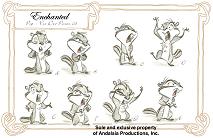 AV: Enchanted is also a combination of the principles of classical animation, the principles of romantic comedy and the principles of action-adventure films. How did you manage to mix and, most of all, balance all these kinds of principles; all these genres that are very specific per se and that, now, are mixed together?
AV: Enchanted is also a combination of the principles of classical animation, the principles of romantic comedy and the principles of action-adventure films. How did you manage to mix and, most of all, balance all these kinds of principles; all these genres that are very specific per se and that, now, are mixed together?
KL: I didn’t sleep! That’s how I did it! You know what? What I did was that I looked back to the classic Disney animated films. I said: “How does a Disney animated film balance all of these genres?” Because very, very often in those films, especially in the Renaissance of Disney animation with The Little Mermaid and Beauty and the Beast, they tended to balance a lot of different genres. You know, this movie is a romantic comedy, it’s a musical, it has action-adventure elements and it’s a 2D and 3D animated film, all in one. So, I looked back to what we had done with those classic films and used that in my structure. That gave me confidence that I could balance them all. It was never easy, I have to admit, and I was often very frightened that it wouldn’t work, that somehow the movie would be too sincere or would lean too much towards the romantic comedy and loose its reference point to Disney animation. But I just had to keep working on material. You know, I actually storyboarded the whole movie before I shot it. I did that because I wanted to gain an understanding of how all the pieces fit together. I wanted to have some security that it was going to work.
AV: Did you storyboard the movie just like you would have done for an animated film?
 KL: For some things, I worked very much like for an animated film, exactly down to each piece of entertainment in the scene. Happy Working Song was done very much that way, where I knew what I wanted to see down to a precise action within the scene. Now, I didn’t impose that upon the rest of the movie. There were times where I just wanted to use storyboards to understand the dynamic and the characters goals within a scene, because I’m a visual artist first and sometimes I find it difficult to translate the written words. So I wanted a dressed rehearsal, in a sense. And then I would go on the day with a certain amount of confidence because I was armed with information and then I would let the day happen. I would invite the actors into a collaboration and the scene would evolve in the moment. I embraced that part of what making a live-action movie is all about. So, I did both, wherever it seemed appropriate for the action on screen.
KL: For some things, I worked very much like for an animated film, exactly down to each piece of entertainment in the scene. Happy Working Song was done very much that way, where I knew what I wanted to see down to a precise action within the scene. Now, I didn’t impose that upon the rest of the movie. There were times where I just wanted to use storyboards to understand the dynamic and the characters goals within a scene, because I’m a visual artist first and sometimes I find it difficult to translate the written words. So I wanted a dressed rehearsal, in a sense. And then I would go on the day with a certain amount of confidence because I was armed with information and then I would let the day happen. I would invite the actors into a collaboration and the scene would evolve in the moment. I embraced that part of what making a live-action movie is all about. So, I did both, wherever it seemed appropriate for the action on screen.
AV: Speaking about the relation between animation and live-action, animation is about caricature. How did you deal with that dimension as you directed the movie? I mean, how did you deal with the fact that live characters like Giselle come from animated caricatures, but as the same time have to interact with real people within a real world? How did you direct them in that matter?
KL: Oh, my! That’s a very complex question because it is probably at the heart of why the movie works so well. Part of it was casting, I have to admit. I had to find the right actors, the actors who could invest in the characters, invest in the inner journey of the characters and not judge the characters, you know what I mean? I wanted them to be able to live in the body of an animated character and never look back at their performance while they were acting, and judge them. I did never want Giselle to think of herself, the actress to think of her character as being ridiculous. And one of the wonderful things about Amy is that she hasn’t for a second lost sight of who she is. She embraced the idea that Giselle is a two-dimensional thinker, that she believes in her dreams whole-heartedly. Then, the character grows and learns things about herself and that’s where, I think, the maturity of the movie sets. She doesn’t just stay in that one place through the entire movie. She becomes a fully-formed, three-dimensional woman. And she takes very much sort of the path from the child to the adult, you know. At the beginning of the movie, she’s very simplistic and has a very idealized viewpoint of the world. And as she grows into a human, into a woman, she acquires a much more complex sensibility: she discovers that you can feel feelings and emotions within you, that you can believe two seemingly opposite things at the same time, that you can be angry and happy in the same moment, all those pretty complex emotional states.
AV: For Eloise, you directed a live-action movie just like an animated film. Was it the same here?
KL: No. This was kind of different. When the characters come to the real world, I didn’t impose an animated vocabulary on the characters. The characters exist as animated characters, they believe in sort of the same sensibility as animated characters but the movie is in fact shot much more like a romantic comedy. So, I let be the contrast between the worlds.
AV: How did you approach the songs?
KL: Every scene goes back, every scene’s an homage to the original Disney classics. So, what I really tried to do was to point back to those songs and give the audience a twist, and that twist mostly comes in the lyric content of the songs. So, the songs are pretty traditional in their context but a lot of the time, the lyrics are incredibly witty or comment on the facts. And then the visual adds another twist and another level of comment to the songs.
AV: Would you like to make a franchise out of Enchanted ?
KL: You know, that totally depends on the audience. I think if the audience falls in love with Giselle, then we’ll definitely move on and do more with the characters. I would personally love to go on another journey with the characters because I think there’s so much more to learn about how someone like this would interact with our world. So, it’s a possibility but it’s totally in the hands of the audience, now…
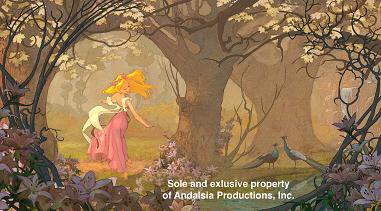
Please click on the many exclusive developmental images from Enchanted throughout both interviews to view larger pop-up versions (your browser will remain on this page). All artwork reproduced by kind permission.
Chris Chase: Bringing The Enchanted Elements Together
 Andalasia is not only an imaginary, ideal, animated place in Enchanted, it’s also the name of the producing/directing company Chris Chase founded with Kevin Lima at the verge of going into doing the movie. As Kevin’s perfect match and producing alter ego, he too has more than one string to his bow, having worked in both live-action and animation. Indeed, he started his career on such varied fare as Eleanor: In Her Own Words, a PBS one-woman special with Lee Remick, Funny, You Don’t Look 200!, Richard Dreyfuss’ ABC special on the birthday of the US Constitution, and Prisoner of Honor, an HBO Film shot on location in the UK.
Andalasia is not only an imaginary, ideal, animated place in Enchanted, it’s also the name of the producing/directing company Chris Chase founded with Kevin Lima at the verge of going into doing the movie. As Kevin’s perfect match and producing alter ego, he too has more than one string to his bow, having worked in both live-action and animation. Indeed, he started his career on such varied fare as Eleanor: In Her Own Words, a PBS one-woman special with Lee Remick, Funny, You Don’t Look 200!, Richard Dreyfuss’ ABC special on the birthday of the US Constitution, and Prisoner of Honor, an HBO Film shot on location in the UK.
Chris joined Walt Disney Animation in 1993 to work on the Mickey Mouse short film Runaway Brain which garnered a 1996 Academy Award nomination for Best Animated Short and was selected to open the 1996 Cannes Film Festival. Following that, he served as associate producer on the 1999 Disney hit Tarzan, co-directed by Kevin, and then as a producer for the theatrical releases of Disney’s Return to Neverland (on which Kevin was a consultant) and Jungle Book 2. Most recently, he served as producer on Lilo & Stitch 2: Stitch Has a Glitch, Disney’s follow up to its 2002 theatrical hit.
Throughout this interview, Chris’ clear love can be felt for filmmaking, artists, creators and other talents. Executive producing Enchanted was for him not only about producing the most magical film, but also about dealing with the rich, human reality of filmmaking he’s so fond of. A human adventure he kindly shares with us now…
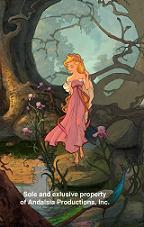 Animated Views: Thank you very much for this interview!
Animated Views: Thank you very much for this interview!
Chris Chase: Thank you! You know what? Enchanted was a very, very special experience. Everybody involved in it loved the film, and particularly my partner, Kevin, you know, who I work with so much. It was something that was right from his heart so, he put all of himself into the making of that film. It was very exciting!
AV: Animation is not at all new for you. Before executive producing Enchanted, you did a lot in that field. Can you tell me about that?
CC: You know, I’ve worked with Kevin for a long time. I actually started thinking I was going to work in theater. There was a point in my life where I had done theater work, I had done film work and my friend Tom Schumacher, who was at that time just moving over to Feature Animation in the days before Lion King, said: “please, you should come in and work with us!” So, I did and worked on a number of different projects and then I started working with Kevin on Tarzan. That was four years of my life and a great, great experience. Kevin is a truly creative man. So, it’s always exciting as a producer to support great creative people.
AV: Then, you produced several Disney sequels, such as Return to Neverland, The Jungle Book 2 and Lilo & Stitch 2. Can you tell me about your experience at Walt Disney Television Animation, then DisneyToon Studios?
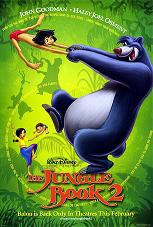 CC: There was a moment in time there when things were sort of changing at Feature Animation. So, at that time there was this group that was doing those sequels. I came on at the end of the first two, Neverland and Jungle Book. They were just needing some work and they asked me to come and help them out, and at the same time, they were developing a sequel to Lilo & Stitch. They knew what I had done at Feature Animation and I think we did make those films better and we helped them be, you know, what they could be given as they were made with a different budget. It was a nice time and I met very nice and talented people there. You know, the artists at Disney in any department are some of the very best ones anywhere!
CC: There was a moment in time there when things were sort of changing at Feature Animation. So, at that time there was this group that was doing those sequels. I came on at the end of the first two, Neverland and Jungle Book. They were just needing some work and they asked me to come and help them out, and at the same time, they were developing a sequel to Lilo & Stitch. They knew what I had done at Feature Animation and I think we did make those films better and we helped them be, you know, what they could be given as they were made with a different budget. It was a nice time and I met very nice and talented people there. You know, the artists at Disney in any department are some of the very best ones anywhere!
AV: How would you explain you role as a producer on all those films?
CC: Well, I think, particularly in animation, there are two different halves that you have to deal with. You know animation is such a technical journey that if you don’t pay attention to the organisation of the process, so that everyone work together, it all can fall apart. So, part of it is making sure you have a structure so that everybody can work together technically as well as artistically. And then the other part is just to make sure, because there are so many people involved, that the director is supported by the right people at the right time over the course of the couple of years that you’re working in it. You want to make sure that you get the right people, art directors, animators, clean-up artists, whoever it is if it’s a 2D, hand-drawn project. So, part of it is knowing both creatively what’s needed at any given time and making sure the directors get the support they need or it’s also knowing how to make sure that the system works and that the people are working in the right possible way.

AV: Can you tell me about the circumstances in which you got involved in Enchanted?
CC: Kevin and I are a producing/directing team and he called me right away and said: “I love this project! We have to do this! We must be involved! This is the project of my heart!” So, he was involved and I was involved and off we went by figuring out how to get it done.
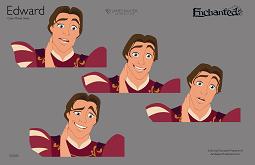
AV: At that time, what was your position regarding Disney?
CC: Actually, I had been part of Disney, but at the time Enchanted started, Kevin and I were going off to set up our own company. So, we are partner in the sense that we’re developing our own material, whether it’s live-action or animated or anything. So, we had just started that when Enchanted came up and it became really the first thing we did together as a post-Disney kind of way, even though, of course, it was for Disney! And right now, we’re in a process of working together to develop new things for Kevin to direct and myself to produce. So, we have new projects that we’re working on.
AV: For Disney?
CC: Some are. We love Disney. Disney has been a big part of both our lives so they’re special to us!
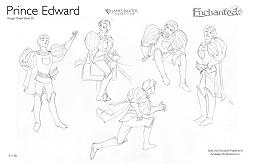
AV: What was exactly your role on Enchanted from the time Disney said “Ok” to yourself and Kevin?
CC: My title is the executive producer, as Kevin’s producing partner. I actually was there everyday with him, from the first day to the last day and handled everything needed to make sure that he’s well supported so he can direct his film. That’s really what’s a real producer ends up doing. We had so many different things that we needed on this film, whether it was songwriters, art directors for the animation versus art directors for the live-action, etc
AV: So, you were the person who hired the artists involved in the film?
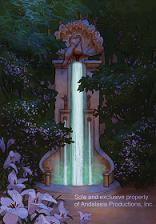 CC: In many cases, yes. Making sure that the right people are in the right place. There were a lot of different producers. The project has been in development for ten years. So, there were producers like Barry Josephson, the very big live-action producer of many famous films, executive producers like Doug Short, who spent many, many years nurturing the film from inside and there also was another executive producer, Sunil Perkash, who is a partner of the writing, who had worked with him at the very, very beginning. He is Bill Kelly’s partner in the way that I’m Kevin’s. So, there was a lot of different producers doing different things to support different person.
CC: In many cases, yes. Making sure that the right people are in the right place. There were a lot of different producers. The project has been in development for ten years. So, there were producers like Barry Josephson, the very big live-action producer of many famous films, executive producers like Doug Short, who spent many, many years nurturing the film from inside and there also was another executive producer, Sunil Perkash, who is a partner of the writing, who had worked with him at the very, very beginning. He is Bill Kelly’s partner in the way that I’m Kevin’s. So, there was a lot of different producers doing different things to support different person.
AV: How did you choose, for example, the art directors for the film. I mean, how did you deal, from that point of view, with the stylistic contrast that was needed between the animated and the live-action world?
CC: Interestingly, it was Kevin who had that big conceptual idea about how to contrast between the two worlds. That is why we ultimately picked Time Square. Because he wanted to go from Andalasia, which was very pastoral and very much of classic Disney nature, to a place which is the ultimate city. So, Kevin had that big idea and then there was a wonderful live-action production designer in Stuart Wurtzel and Lisa Keene, our art director. The three of them all sort of talked together about how to highlight that natural contrast.
AV: That means that you were involved at the same time in both the animated and the live-action part of the process!
CC: I was. I was actually the only executive producer really involved in both. Because I was involved with Kevin and Kevin was involved in everything!

AV: How was it for you to have one foot in one place and the other in another place, all the more since these places are as remote as California for animation and New York for live-action!?
CC: It was very interesting because I had a producer working with James Baxter in Los Angeles, at James’ studio helping day-to-day there because I was with Kevin in New York. But did everything with Kevin, and Kevin and James worked very, very closely. So, sent things back and forth digitally and Kevin would look at them on his computer and we would sort of coordinate the whole process long distance. You know, now, with computers, you can do that in a way you could not have done years ago. So, it was tricky but it was interesting!
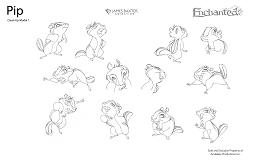
AV: The songwriting team, also, had one foot in each world.
CC: Well, Kevin and I had many discussions about the music in the movie and how to handle live-action musicals. We all know they can be tricky. If you do it right, it can be very, very special and if you do it wrong, people turn away from your movie. So, it our modern-day world, it’s just a very tricky thing. Also, Kevin had a tricky idea which is that he wanted the music to start from classic, classic Walt Disney music and then move more into a modern world as the character of Giselle moves and becomes a more 3D, fully-realized, modern woman. So, we did a lot of agonizing about who could do who could do that, who could both go back and homage the Walt Disney portion and then would also understand a contemporary idea.
Ultimately, there was none else than Alan Menken. Stephen Schwartz was also just great because he’s a wonderful partner for Alan [both pictured below]. He’s a very talented, very strong songwriter himself. So, they both really brought the best out of each other. In fact, we didn’t even know that they would do it. We had no idea. We went to New York and sat down with Alan and ask him: “would you please come and do this?” and he was wonderful! He loved the idea. He had been involved in the project in the past and he was terrific! He just embraced it all!
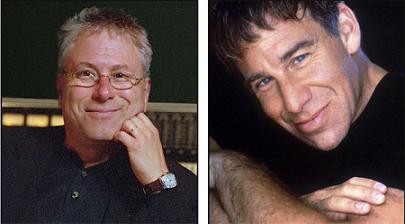
AV: Three of the songs of the film got nominated for the Oscars. What was that experience like?
CC: I look at it all as a big present. I never really expected that a movie about a Disney princess, a movie with animation, was going to be the kind of movie that the Oscars would notice at all. Usually, they like movies that are in every way serious and very intellectual. So, for me, it’s more a tribute to Alan and Stephen, and to Kevin, because, you know, the three of them worked so closely to make sure that the songs fit in the movie really well. Each song fits in its moment, lives in its moment and then evolves. So, you start from True Love’s Kiss, very Disney and you move slowly but surely into a very contemporary place with So Close, and each one becomes a little more part of our world. And that’s really because Alan and Stephen all worked with Kevin. They didn’t give up. They kept going into it until they got just right. I’m just so proud of them!
AV: Speaking of modern-day filmed musicals, it seems to me that the That’s How You Know number is certainly one of the most original and daring ones in the movie.
CC: You know, that’s interesting because that’s exactly what Kevin was trying so hard to do. He wanted to bring back that sense of joy that you get from some of those big numbers in Mary Poppins and some of these classic films and at the same time, he wanted it to be something that an audience today can embrace, young people who are maybe not so familiar with musicals and not so experienced with the genre of classic musical. He wanted it to be modern and referential to the classics. So, you’re exactly right: we spent lots of time, Alan and Stephen and Kevin spent lots of time to find the right tone. And then finally, we had a choreographer to do all the dancing. His name is John O’Connell. He works with Baz Luhrman and he had done Moulin Rouge!, so he was like the fourth piece of the puzzle. He came in and became involved in how to take Kevin’s idea which was: she, by her own nature, gathers people to her and it get bigger and bigger and bigger and so,ultimately, all the people that they meet in the park are involved in this song about love. It really was a collaboration. Kevin had the initial idea and everybody else kept adding to that idea. It was very special.
AV: How was it working 300 extras in Central Park?
CC: It was tough! It was very, very tough! We only had a very limited number of days. I think we had, for the singing and dancing portion itself, like six days. On some of those kinds of numbers, you could spend, you know, 20+ shooting days trying to get it done. We only had a short time so, literally, we were moving through each of those individual setups: the woman with the candelabra on her head or the marching band. Each one of those was just a portion of a day. We had to get it right and move on to the next. It was tough! But the people were so nice! The dancers, the singers and the musicians were so exciting about doing a musical like this. You know, there is anything else like it. So, they were so cooperative and so hard-working and willing to give. It was a very special experience!

AV: Was everything shot in NYC?
CC: I would say it’s all shot in New York. It really is. There was probably a teeny tiny bit that we picked up when we had a little something that we wanted to pick up. We started practically at the beginning of April, which was still quite cold, and then we ended at the July when it was boiling hot.

AV: Speaking of New York, how did you get the idea of the Woolworth Building for the Kings & Queens Ball?
CC: You know, everything in the movie, in a way, is either a reflection of a classic fairytale or a contrast to it. We wanted a modern-day reflection of a castle. If you look at New York and you think about it, the Woolworth Building is such a medieval-looking castle. It’s gargoyles in it, more than any other, it’s very decorated. So, it just seemed so perfect for having a wicked witch transformed into a dragon and taking here the final battle.

AV: During that period, what was your average day like?
CC: Interestingly, I don’t know that we had an average day because they were all different. One day, we’d be inside, in front of a green screen with Susan Sarandon doing something that was going to be ultimately her transformation. The next day, we’d be out in the park, because the weather was perfect, with dancers, or on the street, depending of where we were. The next day, we’d be in a law office that was practically out of the city and the next day, we’d be back in the studio because we were doing the Italian restaurant sequence and that was a set that we built. So, every single day was a very sort of different experience. Some days, we were like shooting a normal live-action movie, and some days, we were doing nothing typical, with 300 extras in the middle of Central Park. That was very exciting!

AV: What kind of relationship did you have with the main actors?
CC: You know what? We were so fortunate! I really appreciated the fact that we had, in addition to talented people, nice people. Amy is terrific. She is fierce and she fights to have everything perfect. And the thing I love about Amy is that, if you watch the movie, she goes from being very “princess” to very real woman. She moved from one thing to the other kind of seamlessly. But then you think about the fact that we shot all out of order. So, one day she’s in that big white dress and the next day she is a real woman in a ball gown, and the next day she’s in the park. Each one had its own level of princess. She was amazing because she tracked where she was in her character arc all the time, and she worked with Kevin to make sure that she was always at the right place in her performance. So, she’s amazing. She’s a talented lady! And Patrick is such a big star in America and he’s such a nice guy. He treats people really well and he was just very sweet.
Jimmy Marsden is wonderful. He’s just the funnest, nicest person. He sang his own stuff as the Prince. I like him like everyone on the movie did because he brought such a good energy on the set. Susan Sarandon is amazing because she’s such a big star and she’s the most down-to-earth person. When you meet her, she’s just like you’re meeting someone you already know. She doesn’t act like a star at all behind the scenes. And also, she’s so experienced. She just brings that experience to the set so that you always feel like: “everything’s gonna be ok! Susan knows what to do!” Of course, I love Tim Spall, our Nathaniel! He a wonderful actor and a wonderful man [chatting on set below, with Chase]. And Idina Menzel, who plays Nancy, is such an amazingly talented lady! I mean, when she sings, it’s just unbelievable. She’s just lovely and talented. So, we were lucky. You know, you never can control how people are but I’m really glad we ended up casting people who also happen to be nice people.

AV: Indina Menzel is a very famous Broadway singer in shows such as Wicked, but in Enchanted she doesn’t sing. Why’s that?
CC: We cast as an actress. That was one of the interesting things. A lot of people have asked us. They know her so well as a singer and they kind of wonder why would we cast her if her main purpose was not to sing. Kevin and I are both fans of her from Rent and from Wicked, and we’ve seen her in other things and we just thought she was a wonderful actress and she felt like the perfect New Yorker. Just like the contrast between Andalasia and, say, Times Square in New York, we wanted a contrast between Giselle, who was a princess from Andalasia and the woman who was quintessentially “New York”. So, it ultimately felt to us that she was the perfect New Yorker.
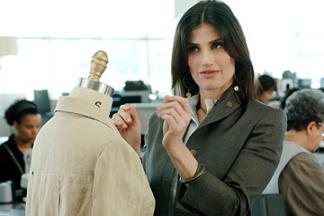
AV: In an early version of the film, didn’t she have a song?
CC: Yes. We had discussed a song that might at the end of the movie, between her and the Prince. You know what? With a different structure of the movie, it would have been a great thing. But, ultimately, the movie just couldn’t be longer. The movie couldn’t support it because she’s not the main character. It’s really not a movie about her. I would love to do another movie which is about her, because I’d love to have her in a movie where she sings! But that’s the kind of hard choice that Kevin always has to make. Sometimes, you have to let things go that are wonderful things and you want to find a place for them, but, you know, you have to stay true to the movie. The movie tells what it needs.
AV: How did you deal with the Disney cameos, all these people like Jodi Benson, who embody so well Disney’s history and who make a special appearance in the movie?
CC: They were lovely. Some of them do a lot of work now, like Jodi Benson [below] who sings and performs all the time and Paige O’Hara, who also performs. We just asked and they were very easy. What Kevin really wanted people to be involved. But at the same time, if you don’t know who Jodi is, it doesn’t matter. But if you do know who she is, how much fun is that!? How fun it is that have that little surprise of her, or Paige O’Hara or Judy Kuhn or any of them. We just thought it would be a great fun!
AV: What was your experience on the post-production part of the film?
CC: I was with Kevin in San Francisco since I followed the movie through from the very beginning to the very end with him. So, we did our post-production at the Presidio in San Francisco which is a big park where George Lucas has his facilities. We rented a room in one of their buildings and set up our editorial group there, close to Kevin. He lives in San Francisco and he wanted to be near his family. Everyday, we worked with Tippett Studios, which are in Oakland and did all the special effects. Animation was still being finished up in Pasadena where James Baxter’s group is. So, all the pieces kind of were coming together at that point.
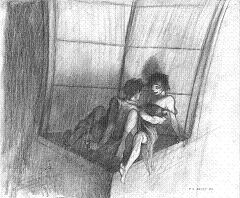
AV: What is your fondest memory of the film?
CC: That’s a tough one! You know, I don’t think it’s one moment. I think I look at the film from before we started shooting, all the way back to March 2005, all the way through to the very last day when we run the publicity junket. It’s all of the days together, for me. I was there for everything, for every piece of it. There for Kevin, there for the team, there for the talented group of people. We had a movie that complicated that it’s really all about just being there and being ready for anything, because everyday is a new challenge. I know this isn’t exactly the perfect answer, but it’s really the whole, it’s being able to stay on it for the whole journey!
I felt very honored to work with so many very, very talented people in so many different disciplines on one film: animation at that level, with James Baxter, with the musicians, Alan and Stephen and everybody involved, with the choreographer, John O’Connell, the actors, the wonderful crew, cameramen, artists, designers, construction people, etc. They all were so excited about working on a movie like this that their whole family could go see. Because many of them usually worked on horror movies or on adult films, things they would never be able to take their kids to. And they finally had something they go take their kids to.
The perfect example of that involvement is a studio executive like Doug Short. He’s a guy who spent a decade making sure that film didn’t get forgotten until the right director could come along in Kevin. Every single person from every single side, whether inside the movie or inside the studio, fought really hard to keep it all alive. And finally, in 2005, when Kevin and I came on board, we had another executive at the studio named Jason Reed. And Jason Reed and Dick Cook, the head of Disney Motion Pictures, were instrumental in actually getting this unusual movie made. I think that’s for me the thing that I will always remember. I don’t know if I’ll ever have that opportunity again. It doesn’t happen very often…

…just for now!
Giselle, Pip and Prince Edward models by James Baxter.
Pip rough models and story by Troy Quane.
Giselle and Book visual development by Lisa Keene.
Castle and Well visual development by Christophe Vacher.
Narissa Beast story drawings by Paul & Gaetan Brizzi.
All Enchanted artworks are sole and exclusive property of Andalasia Productions, Inc. Used by expressed permission. All rights reserved.
All other artwork ©Disney.
With our deepest admiration and all our gratitude to Kevin Lima, and our sincerest appreciation to Chris Chase for their kind and generous help and support. It’s been an honor working with you!


